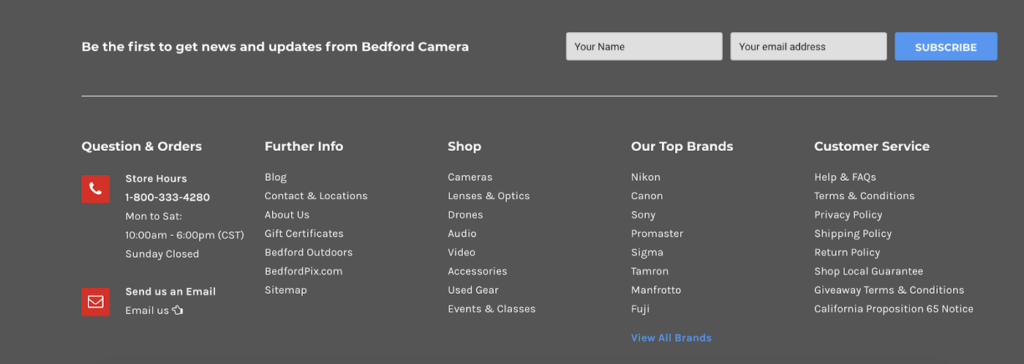This article was contributed by Leigh-Annea at BigCommerce where she researches and discovers strategies to increase organic traffic.
Customer segmentation sorts your regular and prospective customers into distinct groups, making it easier to market directly to different personalities and demographics. Instead of a “one-size-fits-all” marketing approach, try using segmentation to improve the response you get.
The Power of Segmenting Ecommerce Customers
Think about the best ads you’ve ever encountered. Chances are, you felt like those marketing efforts spoke directly to you. When it comes to giving your customers that same impression, customer segmentation is key.
1. New market opportunities.
Part of developing a customer segmentation plan involves determining who you’re trying to reach. While you’re grouping consumers by age, lifestyle, or interests, you might come across groups to target who may have previously been overlooked.
2. Brand awareness.
Personalized emails and targeted marketing campaigns help customers connect with and remember your brand. By offering a unique experience tailored directly to a specific demographic segment of the market, you cement your place in your customer’s mind that you’re the company best positioned to provide what they need.
3. Enhanced competitiveness.
Customer segmentation involves knowing your customer demographics. Insight into specific consumers gives you a competitive advantage over companies with a more general approach to marketing, making it easier to quickly introduce new products and services that appeal directly to your target market.
How to Segment Your Store’s Visitors

If you’ve been in business for a while, you probably have a general idea of who your customers are. Segmenting makes this intuitive sense more formal. There are multiple ways to segment your customer base, but here are some common ways to divide consumers into different target groups:
1. Geolocation or IP address.
Location targeting is a common way to segment market groups. Web-based businesses can collect IP data that indicates precisely where site visitors are coming from. In a physical shop or in-person service business, owners might collect customer contact information to segment clients by area or zip code. Segmentation based on location might take multiple forms.
- Weather: Suggesting products or services based on the weather makes your offerings seem hyper-local and exceptionally relevant.
- Currencies: If your target customer groups include people from around the world, targeting your commerce to local markets and currencies lets buyers know your products are aimed directly at them.
- Languages: Making it simple to switch languages on your website enables consumers to access the most useful version of your site — so you can conveniently serve targeted content directly to that segmented group of consumers.
- Local events: Promoting your products and services to people attending local events, such as festivals or conventions, is an excellent way to reach a specific market segment. Consider how your offerings fit into local events to make this type of market segmentation work. If you sell products that appeal to music lovers, a local music festival might be the right venue for you. Companies that make business software might focus their efforts on the attendees of professional conferences.
2. Traffic source segmentation.
Where your web traffic comes from can say something about the customers buying from you. Monitor with marketing analytic tools how users reach your site to figure out what they’re looking for and where they are in the buying process.
Paid: Paid web traffic includes people who come to your site clicking on ads or links you’ve placed on other sites, such as a Facebook ad or a link from a paid product review. Directing customers to items they’re looking for makes it easier for them to make a purchase, and promoting similar or related products on that same page can upsell items they may not even have considered.
Organic: Organic traffic that comes in through search engines and social media shares can also provide clues about the consumers using your site. Track the sites these visitors have used so that you can better target your marketing. Monitoring search terms can help improve your SEO to better reach customers.
3. Type of device or technology used.
Modern consumers often search on multiple devices, including phones, computers, and home voice assistants. Tailoring marketing campaigns to specific types of technology lets you reach customers wherever they are.
- Mobile: With mobile devices accounting for about 74% of retail site visits in 2022, phones are an ideal place to target customers. Smartphones and other mobile devices have less available screen space than a desktop or laptop computer, so ads or landing pages should include only a limited number of items to fit into the small space.
- Web browser: The specific equipment your clients use may help you determine pricing and outreach strategies. Users who log onto your site via a sophisticated gaming computer might have more money to spend on games or accessories that improve their computing experience. Customers using inexpensive laptops or convertible computing devices might be a better target for productivity software or personalized clothing.
- Voice assistants: Voice search is a growing market, with estimates predicting up to 8 billion voice assistant devices in use by 2023. Consumers often use voice search to look for answers to immediate questions, making it easy to direct targeted ads toward those consumers. You may consider setting up a cookware ad campaign directed at customers asking their voice assistants for recipes or creating a targeted campaign for pet owners referencing a dog or cat.
4. Demographics.
Demographic data about your customer base lets you tailor specific ads toward consumers at different stages of life. Segmenting customers this way also lets you follow them through different life events and change how you market to each group over time.
Age: Grouping customers by age range is a common way to customize your marketing efforts. You might create a marketing campaign that emphasizes the most vibrant, exciting aspects of your product to younger clients and a separate set of ads highlighting consistent, reliable performance for older clients.
Gender: Segmentation by gender can also be coordinated with age segmentation to reach different consumer groups. Fashion, home, and parenting brands often segment customers by gender.
5. Returning vs. new customers.
Reaching new buyers takes a different approach than customer retention. Segmenting your clients into new and returning customers enables you to create different strategies for these two groups.
Customer Segments Create Ecommerce Personalization Opportunities
Personalization involves serving up the right ad at the right time to the customer who’s most likely to respond to it. Segmentation is crucial to successful personalization because you need to identify your target audience to reach them.
Before you can determine which groups you want to target, you need to collect data on your existing customers and the potential market for your goods. Once you have this data, you can start segmenting your market into groups and creating personalized ad campaigns that target each group.
Use cookies and logins to determine whether each customer is a new or returning visitor to your site. Consider offering first-time visitors a one-time discount to encourage an immediate purchase. For repeat customers, use targeted ads on each page to recommend products similar to those they have previously browsed or bought, giving each visitor a custom experience on your site.
The device each customer uses and their behavior patterns on your site also surface opportunities for personalization. For example, desktop users have a higher average order value (AOV) than mobile users, with desktop orders having 24% more items per order.
4 Ways to Personalize Your Ecommerce Site
Personalization takes your customer segmentation one step further, with specific suggestions catered to a particular individual user. You can personalize your ecommerce site by serving up suggestions based on that specific shopper’s prior on-site and purchase behavior as well as their demographic group or physical location.
1. Suggest complementary products.
One of the best times to personalize your marketing is during or right after a sale. Because you already know what the customer has purchased or placed into their online cart, you can suggest complementary products specifically tailored to their interests. Bliss World offers an example of this type of complementary suggestion by placing a Perfect Pairings bar on each product page to encourage buyers to browse the entire collection.

2. Personalize search results.
Set up your internal search results to prioritize results related to your customer’s prior behavior. That might mean tailoring results to the demographic data you have collected on the client or serving up products matched to the customer’s current location. It might also mean putting items first in a search that the customer has previously tagged as a favorite or saved in a list. The example below shows how Hush Puppies enables customers to add items to a wishlist, which can be used for targeted search results later.

3. Use geo-local tagging.
Geo-local tagging uses information that your customers share to track where they are. You can create ads that only get served to people within a specific venue or inside one particular geographic area, which could also include offering discounts when someone checks into your physical location online.
One use of geo-local tagging might be to limit ads specifically to a pre-identified demographic within the city limits of your business location.
4. Send a personalized email.
Personalized emails help you keep in touch with existing customers and encourage them to return to make another purchase. Set up your online store to automatically send a customized email to customers who abandon their shopping carts, reminding them of items left in the cart, and send follow-up emails after a sale to recommend a complementary accessory for whatever the client just purchased.
Place an email signup form on your main page, as Bedford Camera does in the example below, and track customer purchases to ensure that each email recipient is getting relevant messages.

Conclusion
Customer segmentation and personalization not only makes it easier to reach target markets, but also more probable to close a sale. When clients feel a connection with the company, they’re more likely to trust your recommendations, become regular customers, and recommend you to friends and family.



